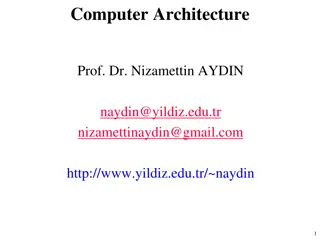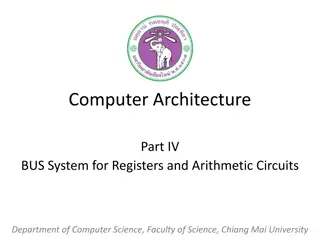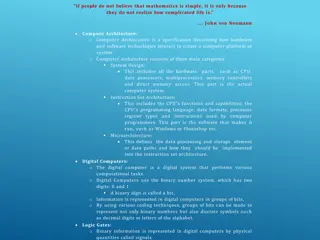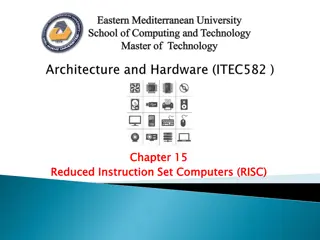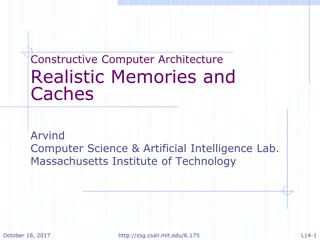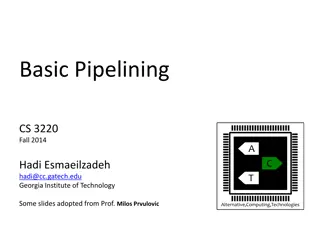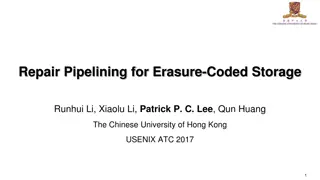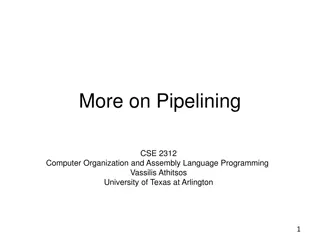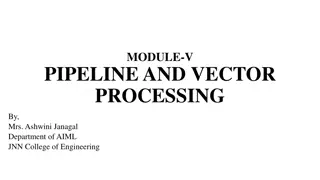Understanding Pipelining in Computer Architecture
Pipelining in computer architecture involves overlapping fetch-execute cycles to process multiple instructions concurrently. It utilizes stages, latches, and throughput to enhance CPU performance. Different forms of pipelining, stage-related terms, and the transition from non-pipelined to pipelined architectures are explored. The advantages of functional unit pipelining for ALU operations are discussed, along with examples illustrating the performance improvements achieved through pipelining.
Download Presentation

Please find below an Image/Link to download the presentation.
The content on the website is provided AS IS for your information and personal use only. It may not be sold, licensed, or shared on other websites without obtaining consent from the author. Download presentation by click this link. If you encounter any issues during the download, it is possible that the publisher has removed the file from their server.
E N D
Presentation Transcript
Pipelining Two forms of pipelining instruction unit overlap fetch-execute cycle so that multiple instructions are being processed at the same time, each instruction in a different portion of the fetch-execute cycle operation (functional) unit overlap execution of ALU operations only useful if execution takes > 1 cycle e.g., floating point operations We will concentrate mostly on instruction unit- level but we will see the necessity for functional unit pipelining later in the semester
Pipeline Related Terms Stage a portion of the pipeline that can accommodate one instruction, the length of the pipeline is in stages Throughput how often the pipeline delivers a completed instruction, our goal is 1.0 (or less!) one instruction leaves the pipeline at the end of each clock cycle would give us an ideal CPI of 1.0 and a speedup equal to the number of stages Stall the need to postpone instructions from moving down the pipeline, stalls are caused by hazards
From Non- pipelined to Pipelined Latches are registers, Denoted as IF/ID.IR And ID/EX.A for example Add latches between stages to control when the instructions can move into the next pipe stages Latches contain logic used to handle forwarding and insert stalls
5-Stage Pipeline Performance CPU Cycles = (n + k 1 + s) * overhead n = number of instructions k = 5 (number of stages) s = stalls, number of stalls inserted is based on the code overhead = pipeline latency which primarily is the time it takes for the logic in the latches to compute as well as extra time to open latches, etc Ideal CPI = 1, actual CPI = 1 + number of stalls per instruction Speedup over non-pipelined machine k / [ (1 + stalls per instruction) * overhead ]
Example Comparison Two processors use the RISC-V ISA both with 4 GHz clock speeds (.5 ns per clock cycle) pipelined processor has latency of .1 ns assume no stalls so CPI = 1 non-pipelined processor has a CPI of 4 cycles for ALU and branches (ALU doesn t use the MEM stage, branches don t use the WB stage) 5 cycles for loads and stores benchmark consists of 40% ALU, 20% branches, 30% loads, 10% stores Non-pipelined CPI = 60% * 4 + 40% * 5 = 4.4 Non-pipelined execution time =.5 ns * 4.4 * IC = 2.2 ns * IC Pipelined machine execution = (.5 ns + 1.ns) * 1 * IC = .6 ns * IC speedup of pipelined machine = 2.2 / .6 = 3.7
Assume Stalls Unrealistic for a pipeline to not stall Assume stalls are needed after Loads and ALU operations of 2 cycles per instruction Branches cause 3 cycle stalls pipeline CPI = 1 + 70% * 2 + 20% * 3 = 3.0 pipeline execution time = 3.0 * 0.6 * IC = 1.8 * IC speedup = 2.2 / 1.8 = 1.22 nearly as slow as the non-pipelined machine! Is the pipeline worth it? yes, we can reduce the number of stalls by modifying the hardware and using the compiler to optimize the code
Problems with the Pipeline Instructions might try to alter the PC at the same time PC incremented in IF branch instruction in EX could alter the PC use a MUX (in the MEM stage) to decide which PC to use Two instructions could attempt to access memory at the same time instruction fetch in IF and data access in MEM use 2 separate caches, an instruction cache for the IF stage and a data cache for the MEM stage Stages take different amounts of time set system clock to slowest stages (those that involve cache access, IF and MEM stages) Hazards these cause stalls, we cover this shortly
Another Example What is the impact different stage speeds? assume IF/MEM take .5 ns each, ID, WB take .35 ns each and EX takes .4 ns non-pipelined machine: execution speed varies by instruction type loads: all 5 stages, ALU: all but MEM, branches and stores: all but WB, time per instruction: loads: .5 + .35 + .4 + .5 + .35 = 2.1 ns ALU: .5 + .35 + .4 + .35 = 1.6 ns branches/stores: .5 + .35 + .4 + .5 = 1.75 ns CPU execution time = 2.1 * 30% + 1.6 * 40% + 1.75 * 30% = 1.795 ns pipeline machine w/ stalls (from previous example) has CPU execution time of 1.8 Now the non-pipelined machine is faster!
Structural Hazards We have already resolved one structural hazard two possible cache accesses in one cycle The other source of structural hazard occurs in the EX stage if an operation takes more than 1 cycle to complete happens with longer ALU operations: multiplication, division, floating point operations we will resolve this problem later when we add FP to our pipeline for now, assume all ALU operations take 1 cycle we will not factor in * or / operations (they will use the FP hardware)
Data Hazards The data hazard arises when a value is needed in a later instruction but earlier in the pipeline Consider the following (s = stall) lw x1, 0(x2) IF ID EX MEM WB addi x3, x1, 1 IF s s s ID value of x1 is not available until the lw reaches its WB stage resulting in 3 cycles of stalls for the addi Stalls are needed to prevent the latter instruction from moving into the ID stage as the datum is not yet ready in the register file for reading data hazards arise when load followed by ALU operation that needs loaded value ALU operation followed by store of computed value loads/ALU operations followed by a conditional branch that uses the loaded/computed value
Solutions We will implement 3 solutions to data hazards as registers are accessed in both ID and WB stages, let WB go first in any clock cycle instructions in ID stage can still access the datum being written to because they access after the WB write this reduce the stalls by 1 implement forwarding (covered in the next slide) shunt value directly from where it was obtained to the waiting stage ALU output to ALU input MEM (from a load) to ALU input MEM (from a load) to MEM (for a store) let the compiler schedule instructions to remove stalls
Forwarding Add logic to latches to determine when forwarding should take place
Forwarding is Not Enough Forwarding will resolve the following situations: addi x1, x1, #4 subi x2, x1, x3 the value of x1 is passed from ALU output to ALU input lw x1, 0(x3) sw x1, 0(x4) the value of x1 is passed from MEM output to MEM input slt x1, x2, x3 beq x1, x2, foo the value of x1 is passed from ALU output to ALU input It does not resolve these two problems lw x1, 0(x2) addi x1, x1, 1 IF ID . EX the value of x1 is available at the end of MEM but needed by the addi at the beginning of its EX, need a 1 cycle stall lw x1, 0(x2) beq x1, x2, foo same IF ID EX MEM WB
Stalling Logic If instruction entering EX stage is a load and instruction entering ID stage requires the use of the loaded value (ALU, load/store where datum is part of the address, branch where datum is part of the branch condition) then stall instruction from entering the ID stage for 1 cycle
Stalling or Scheduling We might be able to remove some of the stalls Compilers can be written to look for these stalling situations loaded datum needed by the next instruction in its EX stage search code for an independent instruction if found, move it into the location after the load code on left requires 1 cycle stalls after each of the lw s, the code on the right does not lw x1, 0(x5) addi x1, x1, 1 sw x1, 0(x5) addi x5, x5, 4 lw x1, 0(x5) addi x1, x1, 1 sw x1, 0(x5) addi x6, x5, 4 lw x1, 0(x5) lw x2, 0(x6) addi x1, x1, 1 addi x2, x2, 1 sw x1, 0(x5) sw x2, 0(x6)
Impact of Stalls Benchmark: 35% loads, 15% stores, 10% branches, 40% ALU of the loads 50% have ALU/branch operations immediately after (case 1) 10% have store operations immediately after (case 2) of the ALU operations 25% have ALU/branch/store operations immediately after (case 3) With no forwarding, each case requires a 2 cycle stall With no forwarding: CPI = 1 + stalls = 1 + .35 * (.5 + .1) * 2 + .40 * .25 * 2 = 1.62
Continued With forwarding 1 stall for case 1 only With forwarding CPI = 1 + stalls = 1 + .35 * .5 * 1 = 1.175 forwarding provides 1.62 / 1.175 = 1.39 speedup Assume compiler can remove 60% of stalls from case 1 CPI = 1 + .35 * .5 * 1 * .4 = 1.07 speedup = 1.62 / 1.07 = 1.51
Branch Hazards PC is updated in MEM stage if branch is taken Three incorrect instructions will have been fetched Three forms of branch unconditional branches, always taken conditional branches, taken when condition is true conditional branches, not taken when condition is false In our 5-stage pipeline we don t worry about untaken branches because we are already fetching the next sequential instruction but taken branches are common and result in a heavy penalty
Branch Penalty If the branch is taken, instructions i+1 and i+2 should not have been fetched, but we do not know this until instruction i completes its EX stage If the branch is not taken, i+1 and i+2 would need to be fetched anyway, no penalty
Branch Penalty The reason for the penalty is we have to wait until the new PC is computed PC + offset, using the adder in the EX stage perform the condition testing in EX (for conditional branches) both of these steps take place in the EX stage but the MUX to update the PC is in the MEM stage as this is the 4th stage of our pipeline, 3 additional instructions will be fetched by the time we know if and where to branch to 3-cycle branch penalty these 3 instructions are flushed from the pipeline we can slightly improve over the 3-cycle penalty by moving the MUX into the EX stage gives us a 2 cycle penalty can we do even better?
RISC-V Solutions to Branch Penalty Hardware solution both PC and offset are available in ID stage offset needs to be sign extended during ID stage remember that the ID & WB stages are the shortest, can we do more in the ID stage? conditional branches compare two registers both registers are fetched during the second half of the ID stage comparison test is quick, move it to ID stage offset is already sign extended, add an adder to the ID stage to compute PC + offset move MUX to ID stage to select PC + 4 or PC + offset cost: 1 adder benefit: 1 cycle penalty instead of 2 (or 3) Software solution compiler tries to move a neutral instruction into that penalty location known as the branch delay slot
Revised Hardware ID stage receives instruction in IR including offset, and PC offset sign extended PC + Offset computed registers accessed during second half of the cycle comparison performed based on result, MUX in IF stage used to determine whether PC is modified PC (PC + 4) or result of PC + offset
New Source of Stall Consider the following sequence of instructions lw x1, 0(x2) beq x1, x3, foo Before we implemented forwarding, we would need to postpone the beq in its IF/ID latch while the lw moved through its MEM stage After forwarding, we needed a 1-cycle stall lw IF ID EX MEM WB beq IF ID s EX WB But with branches moved to the ID stage, we need a two cycle stall lw IF ID EX MEM WB beq IF s s ID EX WB
Filling the Branch Delay Slot Compiler looks for a neutral instruction to move into the branch delay without this, if branch is taken, instruction after branch is incorrect and must be flushed with this, whether branch is taken or not, this instruction will execute and so no penalty
Impact of Branch Hazards Assume a benchmark of 30% loads, 10% stores, 40% ALU operations, 16% conditional branches and 4% unconditional branches, assume 67% of conditional branches are taken assume for all conditional branches that none of the registers are loaded from memory but instead computed using ALU operations Compute impact of branches if original pipeline with no compiler scheduling revised pipeline with no compiler scheduling revised pipeline where compiler can fill branch delay slot 60% of the time
Solution % of instructions with branches taken: 16% * 67% + 4% * 100% = 14.7% Original pipeline, no scheduling = 3 cycle penalty per branch taken CPI = 1 + .147 * 3 = 1.44 Revised pipeline, no scheduling = 1 cycle penalty per branch taken CPI = 1 + .147 * 1 = 1.147 Revised pipeline, scheduling removes 60% of penalties, 1 cycle penalty for the other 40% CPI = 1 + .147 * .4 = 1.059 speedup of revised pipeline with scheduling over original = 1.44 / 1.059 = 1.359 speedup of revised pipeline with scheduling over revised pipeline without scheduling = 1.147 / 1.059 = 1.083
Scheduling Example IF ID EX MEM WB IF ID s EX IF s ID IF Loop: lw x1, 0(x2) x1, x1, 1 x1, 0(x2) x2, x2, 4 addi sw addi subw x4, x3, x2 bne x0, x4, Loop branch delay (lw or next instruction sequential) MEM EX ID IF WB MEM WB EX ID IF MEM WB EX s MEM ID s WB EX IF MEM WB Stalls arise after the lw (data hazard), after the subw (data hazard caused by moving the branch computation to ID) and after the bne (branch penalty) Below, the code has been scheduled by the compiler to remove all stalls with the sw filling the branch delay slot note the adjustment made to the address for storing x1, x2 has already been incremented Loop: lw x1, 0(x2) x2, x2, 4 x1, x1, 1 x4, x3, x2 x0, x4, Loop x1, -4(x2) IF ID IF EX ID IF MEM WB EX ID IF addi addi subw bne sw MEM WB EX ID IF MEM WB EX ID IF MEM WB EX ID MEM WB EX MEM WB
Branches in Other Pipelines Our 5-stage pipeline has a fairly simple solution to branch penalties Some pipelines though are not as simple and so have complicating factors to improve branch penalties stage where target PC is computed might occur earlier than the stage in which the condition is determined this might happen because the PC and sign extended offset are available earlier than when the registers are read if so, we know where to branch earlier than we know if we are branching since most branches are taken, we might take the branch immediately on knowing where to branch to, and only flush the pipeline if later we determine that the branch condition is false
Why Assume Taken? All unconditional branches are taken What about conditional branches? assume 30% of conditional branches are loops a for-loop that iterates 100 times takes its conditional branch 99 times, let s assume 90% of all loop branches are taken the other source of conditional branch is for if/if-else assume 50% of all if-else statements have a conditional branch that is taken let s further assume 75% of all branches are conditional branches percentage of branches taken: 25% (unconditional branches) + 75% * 30% * 90% (90% of all loop branches are taken) + 75% * 70% * 50% (50% of all if-else statement branches are taken) = 71.5% of all branches are taken
Example The MIPS R4000 pipeline has 8 stages branch target locations known in stage 3 branch conditions evaluated in stage 4 unconditional branch Predict taken Predict not taken conditional branch not taken 3 0 conditional branch taken 2 2 2 3 From our previous slide all unconditional branches are taken (25% of all branches) 62% of conditional branches are taken Predict taken penalty = .25 * 2 + .75 * .38 * 3 + .75 * .62 * 2 = 2.285 Predict not taken penalty = .25 * 2 + .75 * .62 * 3 = 1.895 This argues that we should assume branches are not taken for this pipeline
Revised 5-Stage Pipeline Assume we can sign extend the offset and add to the PC in the IF stage requires increasing our clock cycle time by 10% conditions are still evaluated in ID Alternatively, 60% of all branch delay slots can be filled by the compiler Assume a benchmark of 20% branches with 75% being conditional branches which is better, the current 5-stage pipeline with scheduling or this revised pipeline with no scheduling?
Solution 5-Stage pipeline with scheduling 1 cycle penalty arises when branch delay slot cannot be filled (40% for all branches) note: we assume no stalls for loads followed by branches Revised pipeline without scheduling 0 cycle penalty when branch is taken 1 cycle penalty when branch is not taken CPU time without revision = IC * (1 + .2 * .4) * CCT = 1.08 * IC * CCT CPU time with revision = IC * (1 + .2 * (1 71.5%) * 1) * CCT *1.1 = 1.063 * IC * CCT Slowing down the clock but assuming branches taken pays off in this case
Another Strategy: Speculation With branch locations and branch conditions being computed in the same stage, there is no point to assuming taken versus not taken there is also a minimal penalty in the 5-stage pipeline if we can schedule the branch delay slot Other pipelines may benefit by using branch speculation, which we might use in a longer pipeline where branch locations are computed earlier than branch conditions The idea is to predict whether the branch is taken and immediately branch there once we ve computed the new location if we predict taken if we predict not taken, continue fetching instructions sequentially as normal
Implementing Speculation Prediction buffer stored in a cache stores for each branch reached so far its last outcome stored in the cache using the branch instruction s address prediction is merely a binary value taken or not taken in the IF stage when fetching an instruction, access the prediction buffer using the same address only branches are found in the buffer, non-branches result in a miss which we can ignore because by the ID stage we know its not a branch if the buffer gives us a hit and the prediction is to branch, we branch as soon as possible if the instruction is a branch and an entry is not found in the buffer, wait until we know the outcome of the branch condition, perform the branch and store the result in the cache
Poor Prediction Accuracy This approach is not as accurate as we might desire Consider a for-loop that iterates 10 times initially, no entry, no prediction followed by 8 consecutive hits where it predicts taken each time the last iteration is a misprediction as we exit after 10 iterations We reach the same loop again last time through we reset the prediction to not taken because we left the loop so our first prediction is not taken, as is the last iteration We have 2 misses/miss-predictions out of 10 In general, we have 2 mispredictions in a loop rather than 1 Use a 2-bit predictor instead of a 1-bit predictor in which it takes 2 miss-predictions to change a prediction This version gives us n-1 correct predictions for a loop of n iterations
Miss-prediction Rate of 2-bit Notice little difference between 4096 entry cache vs larger cache Predictions This is in part because you don t tend to have more than a few thousand branches
Floating Point FP operations take longer than integer need to unnormalize the FP values, perform the arithmetic, normalize the result back even an FP add might take four times as long as an int add either lengthen the clock cycle time or alter our EX stage to handle variable length operations the former is not preferred as it impacts all operations We replace the current EX stage with a 4-device EX stage integer ALU (for all integer operations except * and /) FP adder FP multiplier (including all integer multiplications) FP divider (including all integer divisions)
New Pipeline Integer unit takes 1 cycle to complete operation FP adder takes 4 cycles FP/int multiplier takes 7 cycles FP/int divider takes 25 cycles FP adder and FP/int multiplier will be pipelined allows a second operation to start rather than stalling until current operation is done no need to pipeline the integer unit divider not used often enough to warrant it being pipelined Functional Unit Integer ALU Data Memory FP Add FP/Int Multiply FP/Int Divide/Sqrt Latency Initiation Interval 0 1 3 6 24 1 1 1 1 25
New Complications Forwarding available from M7/A4/Div/Ex to Ex/M1/A1/Div but more data hazard stalls may be needed Two instructions cannot be permitted to reach MEM at the same time requires a stall Two instructions could reach MEM out of order an int multiplication followed immediately by a FP add will result in the add reaching MEM before the multiplication this introduces new types of data hazards also a problem if the multiplication causes an interrupt after the add has left the pipeline Two divisions cannot be accommodated within 25 cycles of each other
New Stalls fmul.d stalled 1 cycle because of the data hazard with fld fadd.d stalled 6 cycles waiting for fmul.d result forwarded from M7 to A1 fsd stalled 2 cycles waiting for fadd.d result forwarded from A4 to MEM fds stalled 1 additional cycle because otherwise fsd will reach MEM stage at the same time as fadd.d this structural hazard could be eliminated (and thus the stall removed) if the fadd.d could bypass MEM as it does nothing in its MEM stage (we would shunt the fadd.d right to WB) we won t do this because this situation is rare and the solution will require more logic in our latches (greater expense)
Data Hazards Revised We classify data hazards into three categories RAW (read after write) a later instruction needs to read from a register before the write of an earlier instruction has provided it we have handled this through forwarded and/or stalls WAW (write after write) the same register is written to by 2 instructions, but the writes are out of order thanks to different length instructions this form of hazard can not arise with the 5-stage pipeline but can arise with our revised FP pipeline WAR (write after read) this cannot happen in the 5-stage pipeline because all reads are in the ID stage and all writes in the WB stage other pipelines might suffer from this hazard (example shown on next slide)
WAW and WAR Hazards The WAW hazard could not arise in the 5-stage pipeline but could happen in the floating point pipeline fmult.d f0, f2, f4 fadd.d f0, f6, f8 IF ID M1 M2 M3 M4 M5 M6 M7 MEM WB IF ID A1 A2 A3 A4 MEM WB f0 being written to by both instructions but out of order, the result is that the earlier instruction wipes out the result of the latter instruction Consider a pipeline with 2 MEM stages to allow for indirect addressing where each MEM stage is 2 cycles long, and where ALU operations can bypass MEM lw x1, (x2+x3) IF ID Mem1a Mem1b Mem2a Mem2b WB addiw x3, x4, 5 IF ID EX WB in this example, the lw reads x2 in ID but x3 in Mem2a and since writes happen before reads, the new value of x3 (produced by the addiw) overwrites the original address needed by the lw
Handling WAW Hazards The WAW hazard cannot arise in the 5-stage pipeline but can arise in our revised pipeline with the FP units since instructions can finish out of order Logically, WAW hazard makes no sense we are using the same destination without any intervening loads so the first result is never used its like doing the following two instructions sequentially in a program x = y * 5; x = z + 1; in spite of them being illogical, WAW hazards can arise compiler optimizations dealing with branch delays and speculation dynamic scheduling (something we cover in chapter 3) To handle WAW hazards, when detected, the pipeline shuts off the earlier instruction so that it does not reach the WB stage WAR hazards can also arise because of dynamic scheduling but not with standard pipelines we ll find another mechanism for coping with WAR hazards
Handling Interrupts In a non-pipelined machine, interrupts are handled at the end of each fetch-execute cycle handling the interrupt requires saving the important register values (PC, IR, etc) In a pipelined machine, there are multiple instructions and so multiple register values which PC do we save? which IR? Exceptions are somewhat simplified in our 5-stage pipeline IF: page fault, memory violation, misaligned memory access ID: undefined or illegal op code EX: arithmetic exception MEM: same as IF WB: none This list does not include break points or hardware interrupts


![❤Book⚡[PDF]✔ The Apollo Guidance Computer: Architecture and Operation (Springer](/thumb/21611/book-pdf-the-apollo-guidance-computer-architecture-and-operation-springer.jpg)


